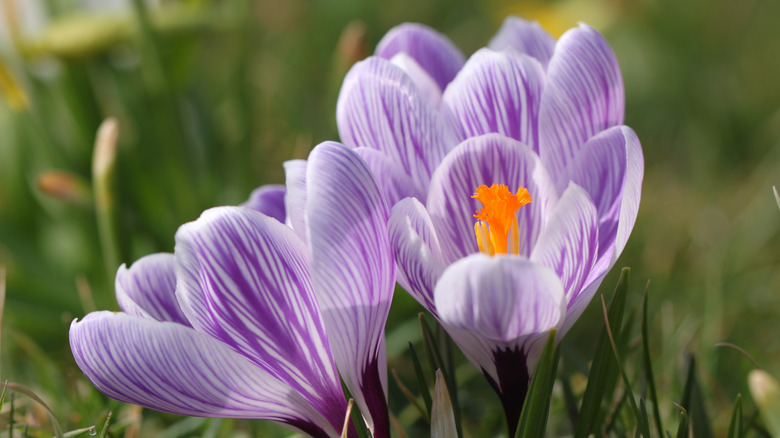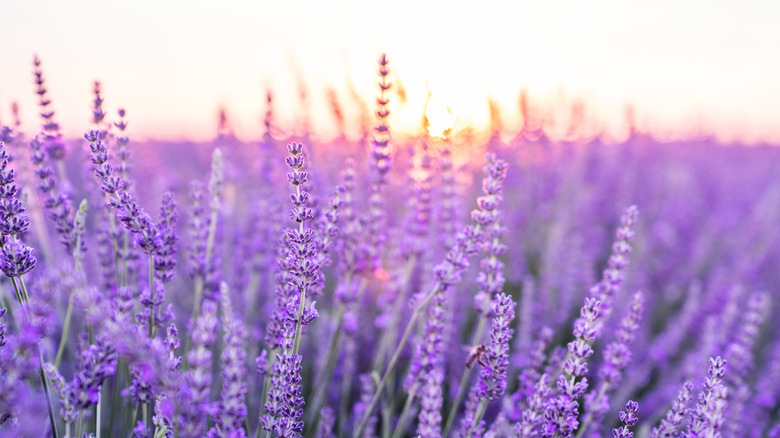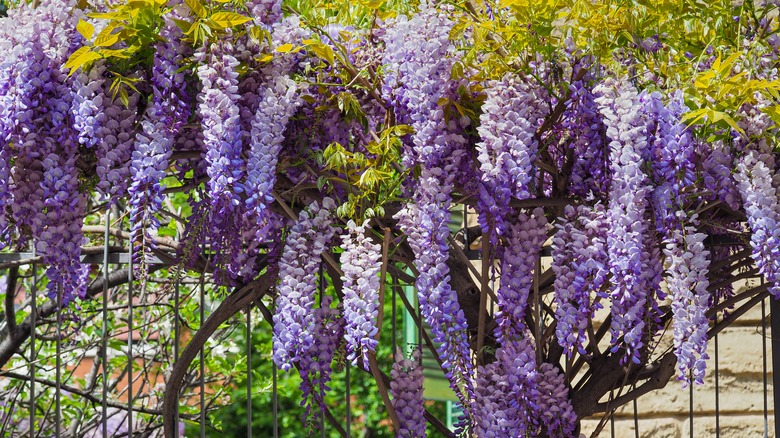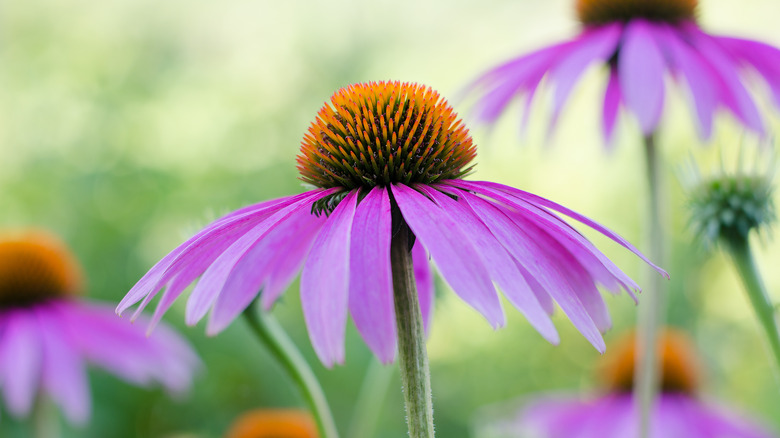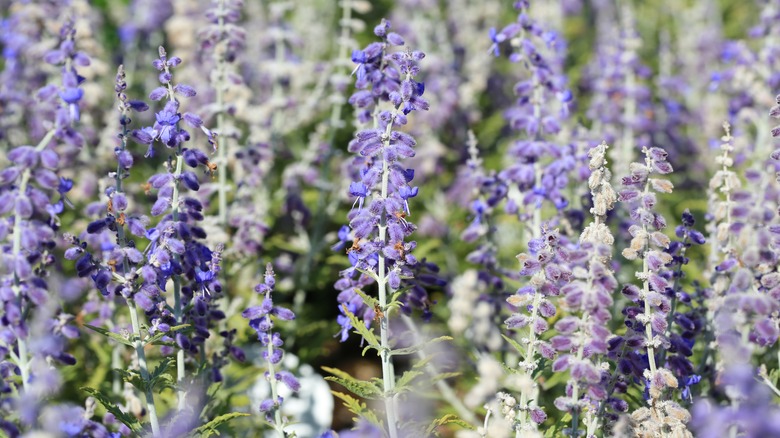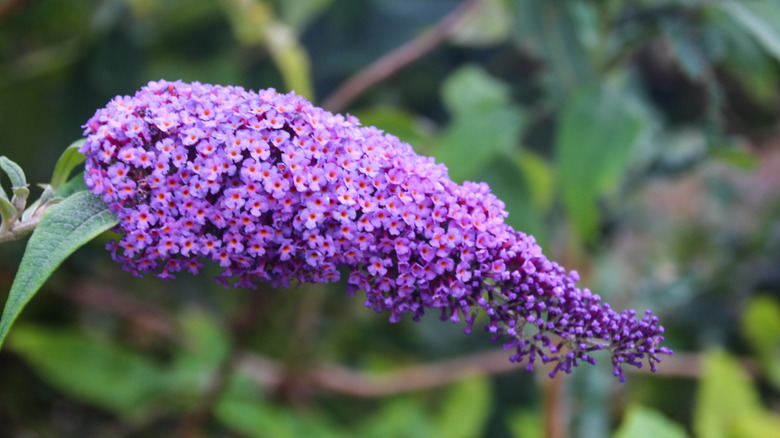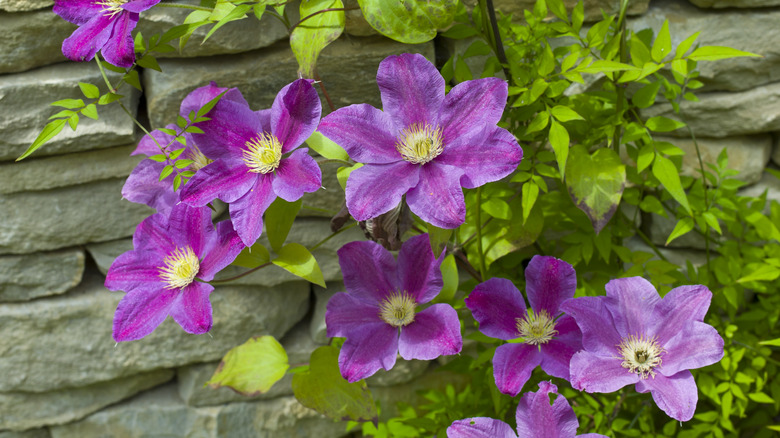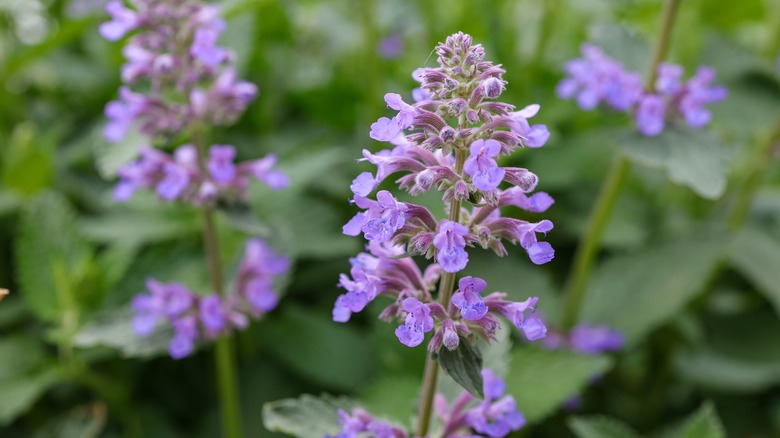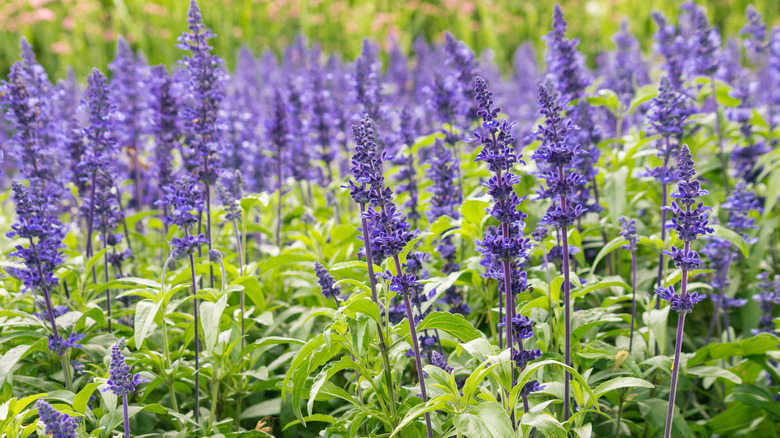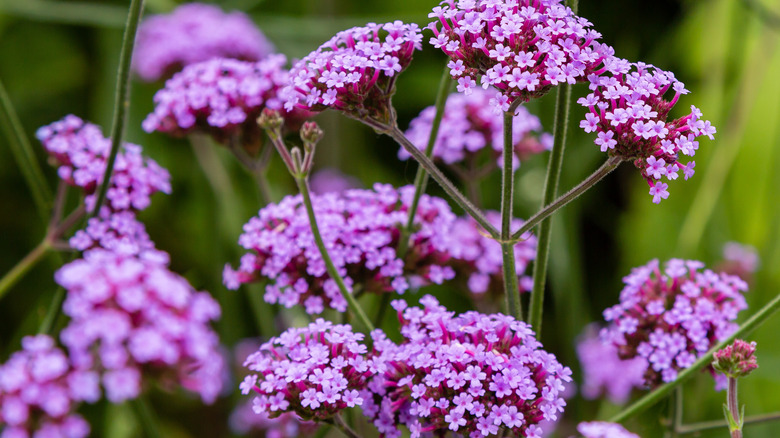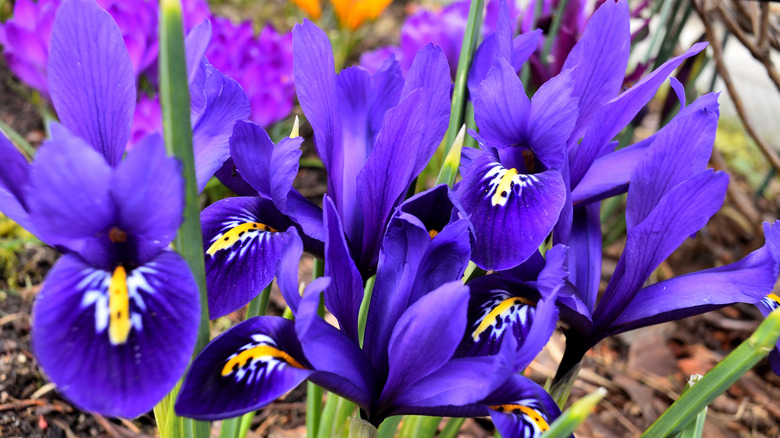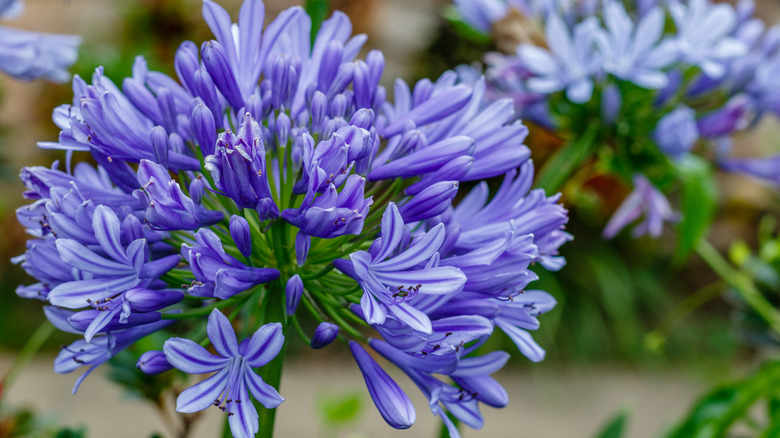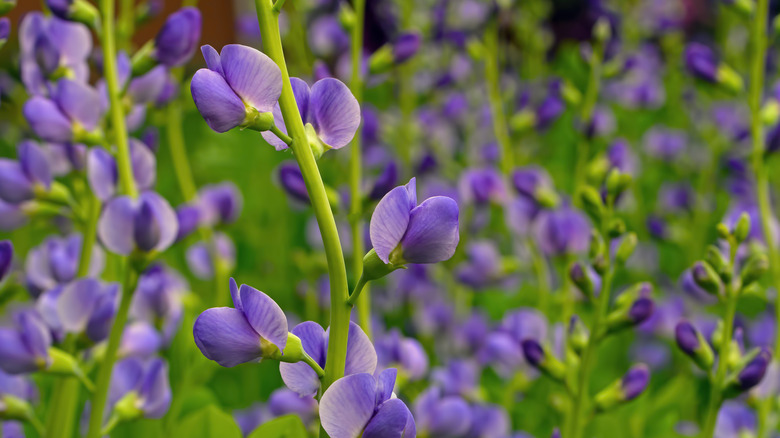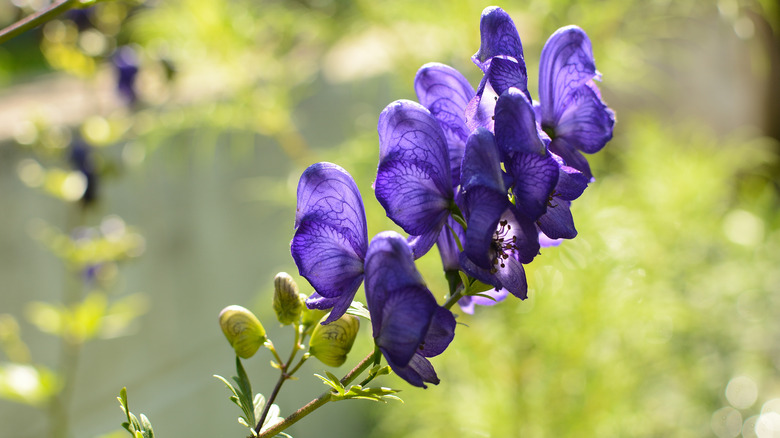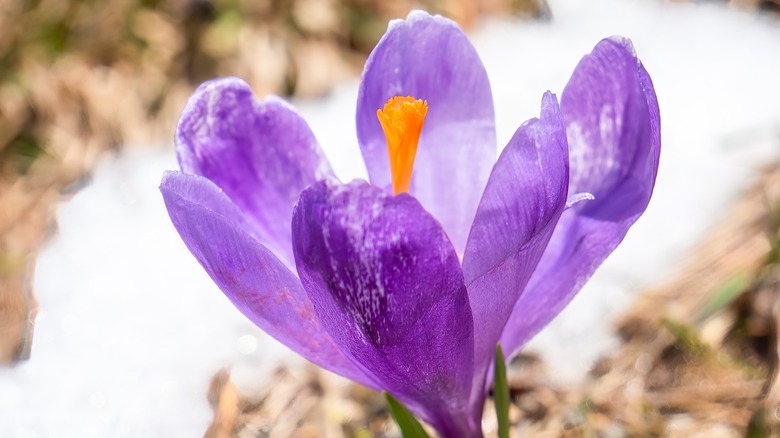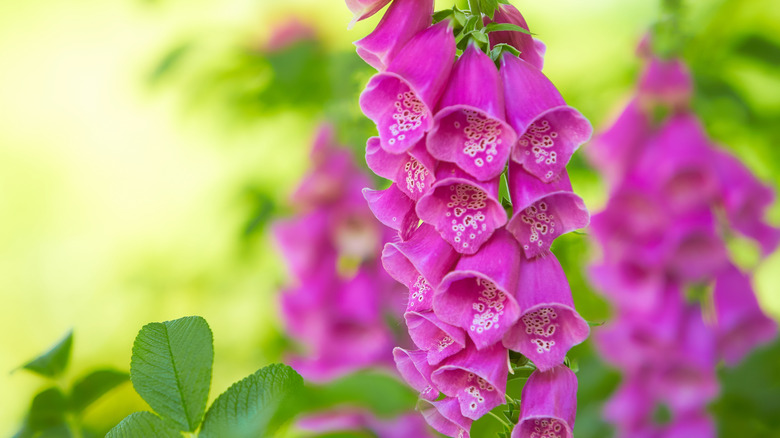15 Stunning Purple Flowers You Should Grow In Your Garden
Designing your garden can be daunting, especially once you introduce colorful flowers. With so many plants and design options to choose from, it can seem like there are endless possibilities — and there pretty much are. While there is no wrong way to landscape your yard, there are a few fun options. For example, you can decorate your yard entirely with your favorite color flowers.
According to Very Well Mind, purple as a color is often associated with regality, mystery, spiritualism, and imagination. Purple is a unique color, as it has the strongest electromagnetic wavelength of perceptible colors. This means that purple is truly unique, as almost everyone has a different perception of it. It also rarely occurs in nature and is often associated with royalty in wealth since purple dye used to be rare and expensive.
Whether you want to add a splash of the unique color to your flower garden or create a whole purple landscape, the outcome will be gorgeous. Though purple may not be the most common color in nature, there are more than enough purple flowers to choose from.
1. Lavender
First on the list is lavender (Lavandula), which can be grown for ornamental and edible purposes. Different varieties grow better for different purposes, but their care needs are generally the same.
White Flower Farms notes that different types of varieties have different hardiness levels — most are fine in zones 5 through 9, whereas Spanish lavender only grows perennially in zones 7 through 9. Lavender plants are very drought resistant once they mature but shouldn't be left to dry out. Provide as much full sun as possible, only giving it afternoon shade in hotter climates.
2. Wisteria
Wisteria is a climbing vine that produces (mostly) purple flowers, creating romantic and fairy-tale-like landscaping scenes. The Royal Horticultural Society says they look best on the front of houses, on sunny garden walls, climbing up a pergola, or otherwise twirling up a fence. Be careful, though, as the strong vines can damage older structures.
Wisteria shouldn't be left to dry out or in soggy soil, so plant in well-draining soil and monitor moisture levels consistently. Potted flowers benefit from occasional feeding with a flowering plant food, while in-ground flowers should get a rose or flowering shrub fertilizer.
3. Purple coneflowers
The purple coneflower (echinacea purpurea) is a member of the Asteraceae, or daisy, family and grows daisy-like purple petals with a larger, dark brown, cone-shaped stamen. The most popular shade is purple, but there are multiple varieties with different colors. They grow best in USDA hardiness zones 3 through 9.
Purple coneflowers do best in full, direct sun but can tolerate partial shade. Hotter climate gardeners should opt for afternoon shade, so the petals don't scorch. They prefer well-draining soil with a high organic matter content but can tolerate less fertile soil, according to Cornell University.
4. Russian sage
Russian sage (perovskia atriplicifolia) is a perennial shrub in the mint family that grows soft lavender-colored flower spikes beginning early in the summer, per The Morton Arboretum. The flower is edible, and Plants for a Future notes that it can be good in salads or as an aesthetic purple garnish. It's also been used to reduce fevers.
The flowering mint relative grows best in USDA hardiness zones 5 through 9 and prefers at least six hours of full sun a day. It prefers well-draining soil and doesn't like consistently wet or soggy soil.
5. Butterfly bush
The butterfly bush (buddleja davidii), also known as summer lilac, is a deciduous, perennial shrub that grows unique purple and pink flower spikes that, as the name suggests, are particularly attractive to butterflies. The University of Maryland warns that they are often considered invasive species, so check with local environmental agencies before planting one.
Butterfly bushes prefer sunny areas with dry and very well-draining soil. They often grow on their own in these areas natively, where they can overtake nearby vegetation. They also grow well in areas along streams and rivers.
6. Clematis
According to the Royal Horticultural Society, Clematis are some of the most popular flowers you can plant in your garden. Different varieties can be grown as climbers or low-laying herbaceous border plants. They are found in multiple shades, including a rich purple hue.
Clematis don't like to be left dry, so monitor their water levels and ensure their soil is consistently moist but not soggy. Pay close attention to container plants. They generally prefer lots of sun, but different cultivars have different preferences. They can benefit from mulching and occasional feeding with a potassium-rich fertilizer.
7. Catmint
Catmint (nepeta) is a perennial member of the mint family that sprouts light periwinkle and purple flowers. According to Gardening with Charlie Nardozzi, while it isn't most cats' favorite snack, some enjoy it on occasion, making it not only a dazzling addition to your garden but practical for your feline friends!
Catmint is a spring bloomer and grows as gray-tinged green ground cover the rest of the year. It can grow as tall as 3 feet during flowering seasons. It prefers full sun, but in warmer zones, you should opt for some shade. Plant catmint in well drained and humus-rich soil.
8. Savlia
Salvias are blue-ish purple flowering plants that grow in both annual and perennial varieties, with different species growing best in different hardiness zones, as noted by University of Florida Gardening Solutions. They grow in thick, dense grass-like patterns, growing up to 4 feet tall and spreading up to 4 feet wide.
The flower can grow in most light conditions but will look best in full sun. They need well-draining soil. Salvias are pretty drought tolerant, so you won't need to do much watering. Consider mulching for moisture regulation, and prune occasionally during flowering seasons.
9. Verbena
Verbena (verbena bonariensis), also known as vervain, purple top, and Argentinian vervain, is a purple flower with darker magenta stems and lighter purple flowers grown in a puff shape. They are great plants for pollinator gardens, Sarah Raven points out.
Verbena need full sun and grow best as a border plant, with some varieties growing as high as 5 feet. They need well-draining soil and benefit from occasional deadheading as the flowers begin to die out, which can help encourage new blooms before the season is over.
10. Dwarf iris
The dwarf iris, or iris reticulata, is a small member of the Iridaceae family. North Carolina Extension Gardener Plant Toolbox states they only grow to be about 4 to 6 inches tall. They are most commonly found in blue variations, but they can also be found with vibrant purple petals. They grow perennially in USDA hardiness zones 5 through 9.
Dwarf irises prefer full sun to partial shade and well-draining soil. They need to be kept relatively moist during their blooming season, so monitor rain patterns to see when you should intervene.
11. Lily of the Nile
Lillies of the Nile (Agapanthus) are not actually native to North Africa but instead to South Africa and parts of Eastern Africa, according to Plantopedia. The perennial flower is a show stopper, with multiple bright purple-blue flowers bursting off one stem head. Some varieties can grow as tall as 6 feet, with average flowers growing between 1 to 3 feet.
Different varieties grow in different USDA hardiness zones, but they grow better in warmer weather due to their naturally warm climate. They do best with full, direct sun and are very sensitive to overwatering.
12. Wild indigo
Wild indigo (baptisia australis), also known as false indigo, got its nickname for being used as a substitute for real indigo in making blue dye, according to Wisconsin Horticulture. It was also historically used by indigenous communities for medicinal purposes, including treating toothaches and nausea.
They love lots of full, bright sun, and while they grow in most well-draining soils, they prefer loamy, gravely, or sandy soils. They are drought resistant once established and mature and are sensitive to overwatering. They grow perennially in USDA hardiness zones 3 through 9.
13. Purple orchids
Monkshood (Aconitum columbianum) is named for its resemblance to the hood of a monk's habit. Also known as wolfsbane, they make a unique addition to your garden — but be warned that they are very toxic. Monica Wilde Forage says that arrows used to be tipped with the plant as poison and that as little as 2 milligrams can kill someone in four hours.
This flower prefers clay-rich, loamy soil that is moist but well-draining, with partial shade (via the Royal Horticultural Society). It is winter hardy, growing in conditions as low as -4 degrees Fahrenheit.
14. Crocus
Crocus is a member of the iridaceae, or iris, family and is identifiable by its vibrant purple leaves and yellow pistil. According to Cornell University, they are low-lying, early spring perennial bloomers. They grow best in USDA hardiness zones 3 through 8.
Crocus needs full sun to part shade light, though too low light may make it lose pigmentation. Provide them with well-draining soil conditions. As a bonus, they grow well indoors and can serve as a unique houseplant.
15. Foxglove
Foxglove, known botanically as digitalis purpurea and commonly known as fairy gloves, fairy bells, and lady's gloves, is a biennial flower that grows natively on mountainsides and in clearings in woodland regions, according to Wisconsin Horticulture. They come in various colors, but one of the most popular and visually stunning is the purple variation.
They grow tall spikes with bell-shaped flowers during flowering seasons (mainly summer) and grow best in USDA hardiness zones 4 through 9. They need full sun to light shade and light, moist, and rich soil. Taller plants may need to be staked.
